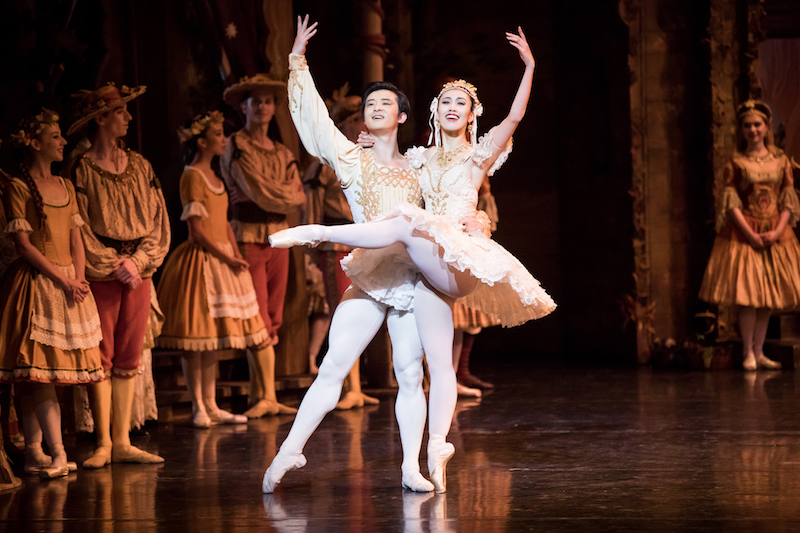Despite a drop in paid attendances, the healthy surplus is due largely to donations, endowments and investments.
The Australian Ballet has released its 2016 Annual Report. Despite total paid attendances for its mainstage programme dropping from 89 percent in 2015 to 84 percent in 2016, and an operating deficit of $0.6 million for 2016, the company has posted a $4.138 million surplus, thanks in large part to income generated from The Australian Ballet Foundation through donations, bequests and investment activities.
 Chengwu Guo and Ako Kondo in Coppélia. Photograph © Daniel Boud
Chengwu Guo and Ako Kondo in Coppélia. Photograph © Daniel Boud
Now in its 55th year, the AB is the country’s wealthiest performing arts company. However, the money generated through its investment gains on endowments and donations is generally not available to fund the operations of the Company, as it is often capital preserved, or is made available to fund limited, prescribed activities.
One of the country’s 28 Major Performing Arts Company, the AB has secure funding from the Victoria and NSW State Governments, as well as the Federal Government, totalling $7.806 million in 2016. In 2016, the AB staged 302 performances and 21 ballets across Queensland, New South Wales, the Australian Capital Territory, Victoria and the United Kingdom, with a total of 345,523 attendances worldwide.
The 2016 mainstage repertoire featured John Neumeier’s critically acclaimed Nijinsky, which received standing ovations in Melbourne, Sydney and Adelaide. However, it was outsold by Peggy van Praagh and George Ogilvie’s Coppélia. Other story ballets in the season included Alexei Ratmansky’s Cinderella and a revivals of Stephen Baynes’ Swan Lake. The mainstage programme also included a contemporary triple bill called Vitesse, and George Balanchine’s Symphony in C. The Company also hosted the Houston Ballet, performing in Australia for the first time in a production of Romeo and Juliet by its Artistic Director Stanton Welch, a former AB artist.
For its 2016 Regional Tour, the AB presented a new, full-length Giselle which played to 14,257 people across Australia, and in a new three-year partnership with Destination NSW and the Penrith City Council, it also presented a free outdoor performance to 6,119 people in Western Sydney with its Ballet Under the Stars Gala. Youngsters were also catered for with two Stoytime Ballets, The Sleeping Beauty and a new Nutcracker. In July 2016, the Company also toured to London where it performed 12 performances of Ratmansky’s Cinderella and Graeme Murphy’s Swan Lake at the Coliseum, playing to 20,311 new audience members.
The mainstage season played to 248,065 people in Melbourne, Sydney, Adelaide and Brisbane. Box office income and other income supporting the artistic programme totalled $30.9 million. However, the costs associated with staging and performing the programme totalled $49.5 million. The increased costs in 2016 were due to the international tour to London, the free outdoor performance in Western Sydney and production costs associated with the Storytime Ballet.
The resulting performance deficit of $18.6 million was mostly, but not entirely, offset by income contributed from the company’s commercial activities, government grants and fund raising from corporate partners and philanthropic patrons. This gave rise to an operating deficit of $0.55 million (before amortisation and depreciation).
As encapsulated in the Director’ Report, mainstage box office revenue was 4.6 percent or $1.34 million lower than in 2015 when an additional commercial season of Graeme Murphy’s Swan Lake generated box office revenue of $2.49 million. However, the Company’s ability to offer a commercial season in addition to its mainstage season is limited by venue availability.
In Sydney attendance figures held firm in 2016 with a 92 percent paid capacity – the same figure as in 2015. However, in Melbourne paid capacity was only 79 percent, down from 87 percent in 2015, while in Adelaide the paid capacity dropped from 87 percent in 2015 to 69 percent in 2016. This meant that total paid attendances for the 2016 mainstage programme nationally dropped from 89 percent in 2015 to 84 percent in 2016.
Box office sales were strong for Nijinksy and Swan Lake in both Melbourne and Sydney, while Coppélia did particularly good business in Sydney. However, box office was lower than expected for the Melbourne season of Coppélia – perhaps because it was performed at the Palais Theatre in St Kilda due to the unavailability of its regular venue, the State Theatre at Arts Centre Melbourne.
Orchestra Victoria – a wholly owned subsidiary of the Ballet achieved a small operating deficit but contributed a surplus of $1.152 million due principally to a significant endowed donation. Taking all its operations and investments into account, the total result for the Company in 2016 was a healthy $4.138 million.
Speaking about the Company’s financial results, AB Executive Director Libby Christie said: “The Australian Ballet’s large community of philanthropic patrons is pivotal to the company’s financial sustainability as the costs associated with staging and performing our artistic program are significant and growing.”











Comments
Log in to join the conversation.